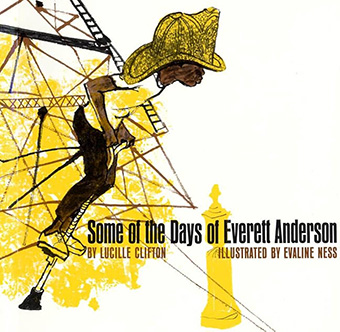Spring is here. With the daffodils and the bloodroot, the tulips and Dutchmen’s britches come thoughts of favorite children’s books.
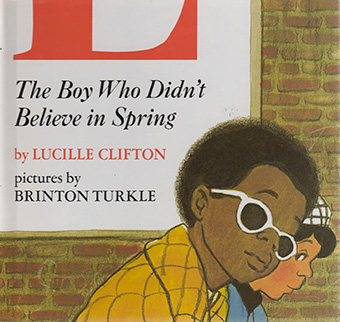 We cannot let the season pass without a mention of Lucille Clifton’s masterpiece, The Boy Who Didn’t Believe in Spring. The book, illustrated by Brinton Turkle, was published in 1973 and has never gone out of print — 52 years in print and it seems as if it were written last year. Spring never goes out of style. And we never tire of reading about the young boy King Shabazz and his friend Tony Polito.
We cannot let the season pass without a mention of Lucille Clifton’s masterpiece, The Boy Who Didn’t Believe in Spring. The book, illustrated by Brinton Turkle, was published in 1973 and has never gone out of print — 52 years in print and it seems as if it were written last year. Spring never goes out of style. And we never tire of reading about the young boy King Shabazz and his friend Tony Polito.
“Once upon a time there was a little boy named King Shabazz who didn’t believe in spring. ‘No such thing!’ he would whisper every time the teacher talked about spring in school.”
When King Shabazz decides he’s had enough talk about spring he puts on his shades and his jacket, finds his friend Tony, and they go out. “I’m going to get me some of this spring,” he says.
Tony and King Shabazz have the kind of small adventures that make up a child’s life. They smell the warm rolls at Weissman’s Bakery. They decide, after mutual hesitation, to cross the street at the stop light (which they have never done by themselves before), they stand by the door at the bar-b‑q takeout and take in that wonderful aroma.
Eventually they come to a small vacant lot. And “…right in the middle — a car! It was beautiful. The wheels were gone and so were the doors, but it was dark red and sitting high on a dirt mound in the middle of the lot.
‘Oh man, oh man,’ whispered King.
‘Oh man,’ whispered Tony.”
But there’s more. “Then they heard the noise.” They find spring on the seat of that old “beautiful” car. And what they find is beauty and wonder in the form of a bird’s nest with four blue eggs.
Then Tony’s big brother Sam shows up and the spell is broken — almost. “Spring is here,’ [King] whispered to Tony.” And we know he is right.
We love these boys. We love that beautiful old rusted out car with bird’s eggs inside it. And most of all we love Lucille Clifton for her skill in showing us the beauty and wonder that is everywhere.
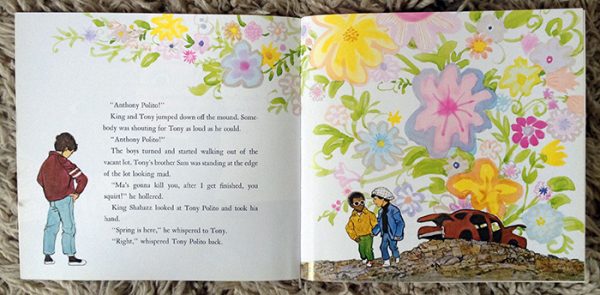
written by Lucille Clifton, Dutton Books, 1973
King Shabazz’s story has never gone out of print, but Lucille Clifton wrote about another wonderful boy, Everett Anderson, and those books are out of print.
Some of the Days of Everett Anderson (1970)
Everett Anderson Christmas Coming (1971)
Everett Anderson’s Year (1974)
Everett Anderson’s Friend (1976)
Everett Anderson’s 1−2−3 (1978)
Everett Anderson’s Nine Month Long (1978)
Everett Anderson’s Good-bye (1983)
One of the Problems of Everett Anderson (2001)
We would love to see a re-issue of these wonderful books. If you agree perhaps you can help by writing to:
Books for Young Readers
Henry Holt and Company
120 Broadway
New York, NY 10271
And we will do the same.
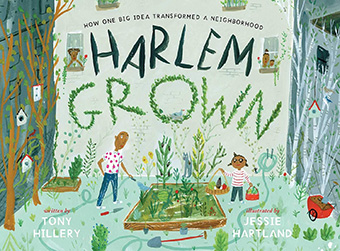 Spring is also a time for planting, for dreaming about gardens. This is a new favorite, a story of transformation, of redeeming something lost. Harlem Grown, How One Big Idea Transformed a Neighborhood, written by Tony Hillery and illustrated by Jessie Hartland, is the story of transforming a junk-ridden vacant lot, across the street from a school in Harlem into a thriving garden, told by the man who did just that.
Spring is also a time for planting, for dreaming about gardens. This is a new favorite, a story of transformation, of redeeming something lost. Harlem Grown, How One Big Idea Transformed a Neighborhood, written by Tony Hillery and illustrated by Jessie Hartland, is the story of transforming a junk-ridden vacant lot, across the street from a school in Harlem into a thriving garden, told by the man who did just that.
“Once/ in a big city/ called New York, / in a bustling/ neighborhood/ called Harlem, /there was/an empty lot. / Neveah called it the haunted garden. / It was cluttered with wrecked couches/ old tvs, broken bottles, and empty cans.”
A man named Mr. Tony began to visit Neveah’s school. And he saw the haunted garden. He developed a plan. And started to clear the haunted garden, “one piece of trash at a time.”
Soon it was cleared and Mr. Tony brought in good soil. He invited Neveah to help. Then he got seeds, plants, shovels, and a hose for water. Niveah’s friends came to help. They planted 400 seedlings, “one for each kid.” As growing season turned into harvest season they gathered “tomatoes, cucumbers, peppers, blueberries, /strawberries, collard greens, kale, basil, arugula.” More kids come to help, more harvests. And then kids take home fresh vegetables, where before there were none.
An author’s note from Tony Hillery says, “Originally one garden plot on 134th St. our urban farm has expanded to 12 sites across Harlem,” that employs 22 full-time staff members. But the real importance of Harlem Grown is more than vegetables, it is the students whose lives have been changed by growing vegetables together. You can hear these students at this link. King Shabazz would like this place.
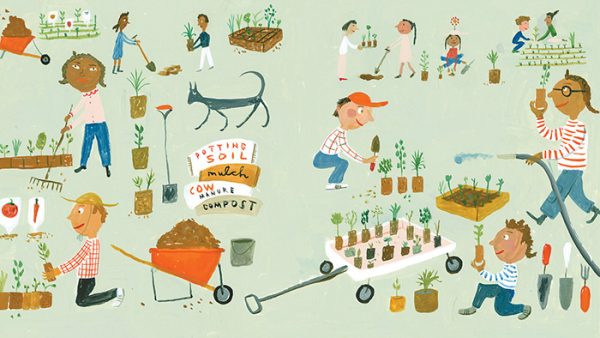
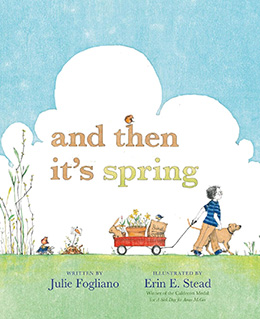 Spring can be a long time coming and while we wait why not read a book, maybe with a friend. Picture books are written to be read out loud, and they are meant to be heard by an audience, a child, or children, or adults. We love when a writer uses syntax and sound to help convey the feeling of the story, and Julie Fogliano has done exactly that in and then it’s spring, illustrated by Erin E. Stead. In a single book-long sentence she conveys the yearning for spring to arrive, evoking a kind of “are we there yet?” feeling.
Spring can be a long time coming and while we wait why not read a book, maybe with a friend. Picture books are written to be read out loud, and they are meant to be heard by an audience, a child, or children, or adults. We love when a writer uses syntax and sound to help convey the feeling of the story, and Julie Fogliano has done exactly that in and then it’s spring, illustrated by Erin E. Stead. In a single book-long sentence she conveys the yearning for spring to arrive, evoking a kind of “are we there yet?” feeling.
Fogliano’s book (and the single sentence) begins
First you have brown,
all around you have brown
then there are seeds
and a wish for rain
and then it rains
and it is still brown
but a hopeful, very possible sort of brown
The child and their dog wait, hope, and worry that birds have eaten the seeds or that bears have stomped on them because bears can’t read signs like “please do not stomp here there are seeds and they are trying.”
Finally the ground has a greenish hum, and on a sunny day after a rainy day “the brown isn’t around and now you have green all around you have green.”
Just as the single sentence ends in a period spring arrives, and our hearts are glad.
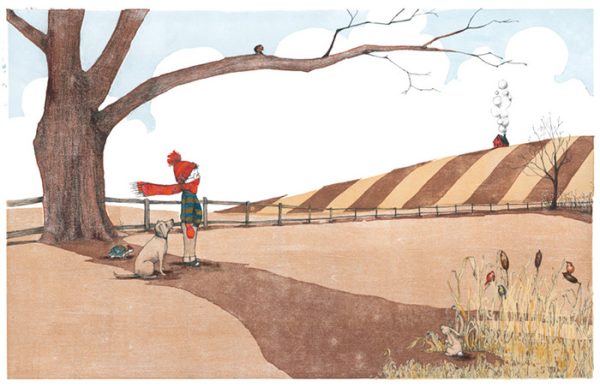
written by Julie Fogliano, Roaring Brook Press, 2012
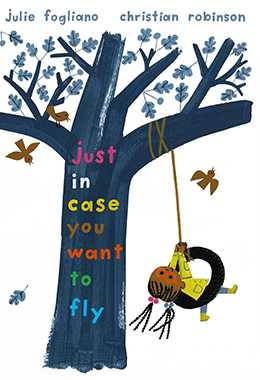 Julie Fogliano is also the author of just in case you want to fly, illustrated by Christian Robinson who uses construction paper, acrylic paint, and cut-out shapes to create bright and cheery pictures. Fogliano dedicates the book “for clio rose, who fills my bag with just-in-cases and for all the little birds with big places to go.” This is a book to appreciate especially if you are someone who always wants to bring along everything you might possibly (or impossibly) need for your adventures.
Julie Fogliano is also the author of just in case you want to fly, illustrated by Christian Robinson who uses construction paper, acrylic paint, and cut-out shapes to create bright and cheery pictures. Fogliano dedicates the book “for clio rose, who fills my bag with just-in-cases and for all the little birds with big places to go.” This is a book to appreciate especially if you are someone who always wants to bring along everything you might possibly (or impossibly) need for your adventures.
The book is packed with all sorts of whimsical just-in-cases. It begins, “Just in case you want to fly here’s some wind, and here’s the sky.” The list goes rhymingly on, “Here’s a cherry if you need a snack” (illustrated with a rhino balancing a cherry on their horn) “and if you get itchy here’s a scratch on the back.” There’s à la la la and a ding ding ding just in case you want to sing, a joke if you want to laugh, a tissue and a sigh in case you want to cry, an umbrella, honey for your tea, and for bedtime a blanket, a dream, kisses, a pillow, and a story.
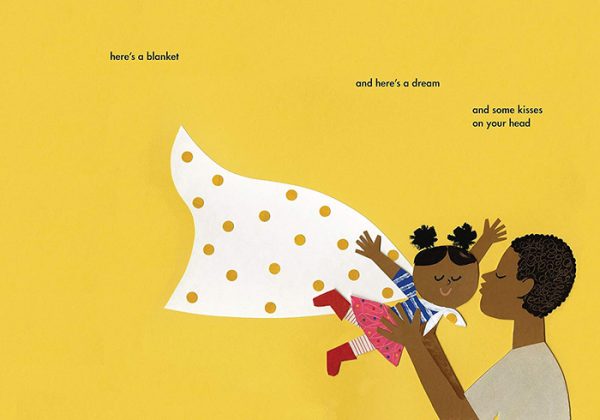
written by Julie Fogliano, Neal Porter Books, 2019
The book ends reassuringly with the comfort of “a map with an x on the spot to find your way home to me.”
This book is good for all seasons — whimsical, charming, and a delight to read out loud. And Christian Robinson’s illustrations fit it perfectly.
Just in case you’d like to take a tour of Christian Robinson’s studio, here’s a link.
And just in case you want a great book to welcome spring, be sure to read some of these.

